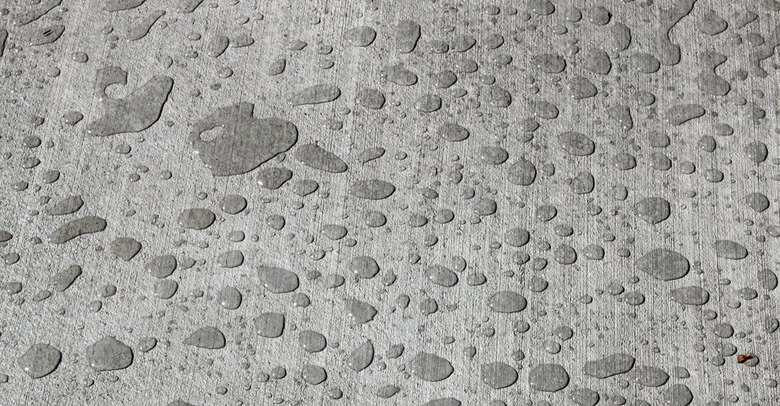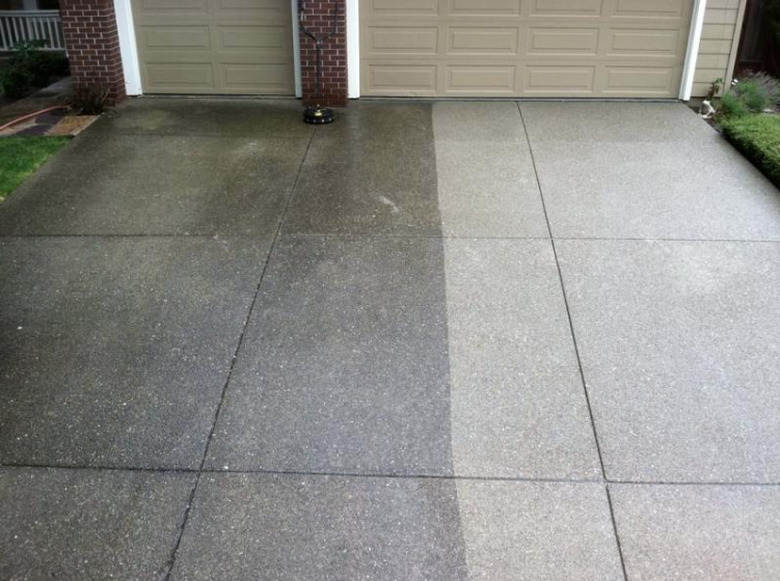How To Waterproof Concrete Surfaces
If you have a concrete patio, garage, or driveway, sealing the concrete should be part of the initial conditioning of the surface, and should be done periodically over the life of the concrete. Waterproofing the concrete protects it from the elements, creating a barrier that repels water but allows trapped water vapors to escape. It diminishes stains from mold and mildew, and increases the concrete's durability by diminishing corrosion, crystalline salts left behind on the concrete's surface (efflorescence), freeze-thaw damage, and the breaking off of small pieces of material (spalling).
You'll find two kinds of concrete sealers: film-forming sealers and penetrating sealers. Film-forming sealer protects the concrete with a layer of acrylic, epoxy, or urethane on the surface. This type is widely available at home improvement stores and yields a wet look or high-gloss finish. It wears out more easily, so you'll have to reapply it more frequently. Penetrating sealer permeates the concrete, forming a chemical barrier, and substances used include silanes, siloxanes, silicates, and siliconates. Also known as impregnating concrete sealer, this type may require purchase from a specialty dealer and be far more expensive, but it lasts much longer—possibly a lifetime—and doesn't change the appearance of the concrete.
Important: You cannot apply sealer to new concrete. Wait at least one month before sealing it, to give the new concrete time to cure completely.
The following instructions assume that you have uncoated concrete. If your surface has been coated before, new sealant may not adhere properly, so you may have to remove it; in that case, follow the directions given by the sealer manufacturer. Even if you don't have to remove the coating, you'll still have to prep it—again, refer to the instructions for the waterproofer. And by the way, if you want to paint the surface after waterproofing, check before you buy that the waterproofer is actually compatible with painted finishes.
Tip
Check the weather and temperature forecast before you start sealing! Sealer won't adhere to damp concrete, so you must have dry conditions. Additionally, temperatures must stay between 50 and 90°F on the day of application and for the two days following, while the sealant cures completely. Also, you shouldn't apply waterproofer in direct sunlight.
Things Needed
-
Push broom
-
Safety equipment: goggles and acid-resistant gloves and boots
-
Cleaner/etcher for concrete
-
Large plastic watering can
-
Long-handled non-metal scrub brush
-
Water hose
-
Plastic squeegee with a long handle (optional)
-
Liquid waterproofer for concrete
-
Large painter's tray
-
Paintbrush
-
Wide roller with a 1/4-inch nap
-
Long handle for the roller
-
Mop
-
Floor-cleaning detergent
Warning
When handling cleaner/etcher, wear safety equipment—goggles and acid-resistant gloves and boots—and if you're working in an enclosed space such as a garage, open the door or make sure to otherwise ventilate it.
1. Clean and Prepare the Concrete Surface
These essential steps get the concrete ready to accept the waterproofer; don't skip them!
- If necessary, protect your walls with plastic sheet. Sweep the concrete thoroughly with a push broom to get rid of dirt and debris. Then thoroughly sweep it a second time. You'll be surprised at how much dust gets left behind in the first sweeping!
- Make sure the concrete is completely dry. Pour the cleaner/etcher into a large watering can. Sprinkle the cleaner/etcher on the surface and leave it on for 10 to 20 minutes.
- Scrub the surface vigorously with a long-handled scrub brush. If the cleaner/etcher begins to dry as you work, mist it lightly with water to keep it wet.
- After scrubbing, hose down the surface thoroughly to rinse it, but don't let the rinse water go down storm drains.
- If desired, use a squeegee to push water off the concrete, then let the surface completely dry, at least overnight (24 hours is better).
Properly prepared, the surface should feel like medium-grit sandpaper. To achieve this on stained concrete or concrete that has a smooth, dense finish, you may have to apply cleaner/etcher more than once. After the surface dries, there should be no residue or loose concrete—run your finger lightly on the concrete, and if it comes away with dust on it, rinse again.
2. Apply Waterproofer/Sealer to the Concrete Surface
Depending on the porosity of your concrete, a gallon of waterproofer can cover 250 square feet.
- Pour some waterproofer into a large painter's tray. If you're sealing an indoor area, use the paintbrush to apply sealant to the floor along the edges of the walls. That way, you'll avoid touching the walls with the roller in the next step.
- Apply the sealant to the roller from the painter's tray, loading it fully. Roll it onto the concrete, saturating the surface completely. If the sealer puddles, spread it to drier areas.
- Let the first coat of sealer dry.
- If your product requires a second coat, roll it on in the opposite direction from the first coat to ensure even coverage.
- Allow the sealer to dry and cure. Most sealers require 24 to 48 hours to cure.
3. Concrete Surface Aftercare
Check the product for specific drying directions, but in general, you should wait at least three days before allowing heavy foot traffic onto the sealed surface, and 14 days before driving on it. Wait 30 days before cleaning with a mild floor-cleaning detergent and mop.
Areas that receive heavy traffic may need to be touched up annually. You may need to reseal periodically, depending on the type of sealer used and the amount of wear and tear the surface receives. You can tell it's time to reseal if water soaks into the concrete instead of beading on its surface, and if the concrete looks scratched, dull, or dirty. Acrylic waterproofer lasts one to three years. Epoxies, polyurethanes and polyaspartics can go five to 10 years between applications. Penetrating sealers may never require a reapplication.

